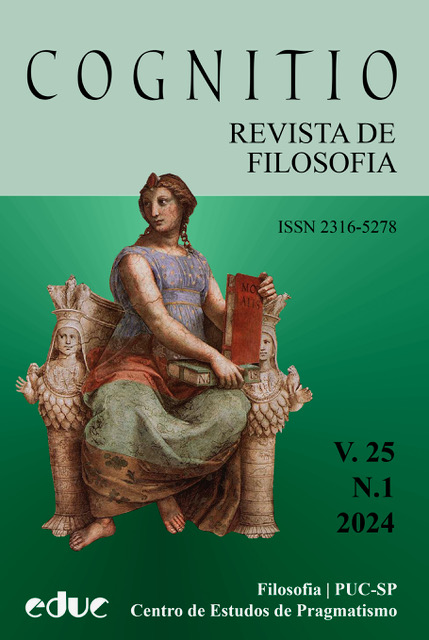The digital summum bonum
an aesthetic and phenomenological reading of the video game Bloodborne through Charles S. Peirce
DOI:
https://doi.org/10.23925/2316-5278.2024v25i1:e65222Keywords:
Aesthetics, Phenomenology, Charles S. Peirce, Videogames, Meaningful Playful Interaction, BloodborneAbstract
The objective of this work is to relate the three aesthetic principles, or pleasures, of a videogame, that is, immersion, agency, and transformation, with the summum bonum and the phenomenological categories of Charles S. Peirce. The summum bonum can be understood as a mixture of feeling, action, and reason. The player's feelings, actions and thoughts are responsible for concretizing and broadening this aesthetic horizon. Immersion is an aesthetic principle of firstness. We can understand the act of immersion as a pleasure of firstness - because the player, metaphorically and literally, goes to another place, being unrelated to what is outside the immersion. The aesthetic principle of agency is governed by secondness. You get pleasure from forcing yourself against the game world, controlling it mechanically, acting and reacting. All games have secondness, but competitive games, like fighting games, racing games, and even some online RPGs, have strong characteristics of mechanical force, clash, action, and reaction. The third and final aesthetic principle is transformation. Transformation is a process. Videogames that allow different approaches tend to be games in which there is a process of growth, both in terms of gameplay and the game's narrative itself. The gameworld and the character are transformed into something different over time - there is an evolution, and this evolution is characterized as a phenomenon of thirdness. It was concluded that, although all videogames have these three aesthetic principles, each individual game favors one or two of these principles. It is precisely these aesthetic principles that will direct the choice of what is played, much more than the theme or genre of the game.References
DUTRA, D. I. O horror sobrenatural de H.P. Lovecraft: teoria e praxe estética do horror cósmico. 2015. 260 f. Tese (Doutorado em Literatura Comparada) – Universidade Federal do Rio Grande do Sul, Porto Alegre, 2015.
JOSHI, S. T. The weird tale. Seatle: Sarnath Press, 2017.
LOVECRAFT, H. P. A maldição de Sarnath. 2. ed. São Paulo: Iluminuras, 2001.
McGONICAL, Jane. A realidade em jogo: Porque os games nos tornam melhor e como eles podem mudar o mundo. Rio de Janeiro: Best-seller, 2017.
McLUHAN, Marshall. Os meios de comunicação como extensões do homem. 13. ed. São Paulo: Cultrix, 2003.
MURRAY, Janet H. Hamlet no Holodeck: o futuro da narrativa no ciberespaço. São Paulo: Itaú Cultural/Unesp, 2003.
NESTERIUK, Sergio. Jogo como elemento da cultura: aspectos contemporâneos e as modificações na experiência de jogar. 2007. Tese (Doutorado em Comunicação e Semiótica) – PUC, São Paulo.
NEWMAN, James. Videogames. 2. ed. New York, NY: Routledge, 2013.
NÖTH, Winfried. Máquinas semióticas. In: QUEIROZ, J.; LOULA, A.; GUDWIN, R. (org.). Computação, cognição e semiose. Salvador: EDUFBA, 2007.
NOVAK, Jeannie. Desenvolvimento de games. São Paulo: Cengage, 2015.
PEIRCE, Charles S. Semiótica. São Paulo: Perspectiva, 2003.
QUEIROZ, João. Semiose segundo C. S. Peirce. São Paulo: EDUC / FAPESP, 2004.
RUIZ, M. F.; BIENVENIDO, H. P. Universos fantásticos de inspiración Lovecraftiana en videojuegos survival horror: un estudio de caso de p.t (silent hills). Brumal: Revista de Investigación sobre lo Fantástico, Barcelona, v. 3, n. 1, p. 95-118, 2015. https://doi.org/10.5565/rev/brumal.177
SALEN, Katie; ZIMMERMAN, Eric. Regras do jogo: fundamentos do design de jogos: principais conceitos. v. 1. São Paulo: Blucher, 2012a.
SALEN, Katie; ZIMMERMAN, Eric. Regras do jogo: fundamentos do design de jogos: regras. V. 2. São Paulo: Blucher, 2012b.
SALEN, Katie; ZIMMERMAN, Eric. Regras do jogo: fundamentos do design de jogos: interação lúdica. v. 3. São Paulo: Blucher, 2012c.
SANTAELLA, Lucia. A assinatura das coisas: Peirce e a literatura. Rio de Janeiro: Imago, 1992.
SANTAELLA, Lucia. Estética: de Platão a Peirce. 2. ed. São Paulo: Experimento, 1994.
TAVINOR, Grant. The Art of Videogames. Hoboken, NJ: Wiley-Blackwell, 2009.
TESSARO, Annye Cristiny. Narrativas e games: um olhar do design literário-artístico. 2018. Tese (Doutorado em Tecnologias da Inteligência e Design Digital) – PUC, São Paulo.
Downloads
Published
How to Cite
Issue
Section
License
Copyright (c) 2024 http://creativecommons.org/licenses/by/4.0/

This work is licensed under a Creative Commons Attribution 4.0 International License.









